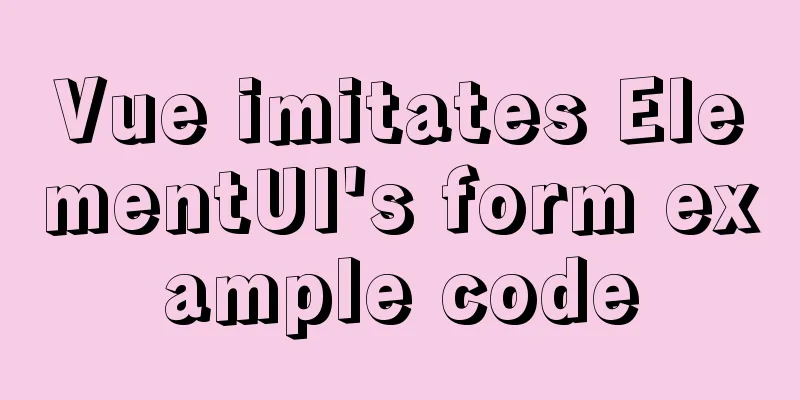Vue imitates ElementUI's form example code

Implementation requirementsThe form imitating ElementUI is divided into four layers: index component, Form form component, FormItem form item component, Input and CheckBox components. The specific division of labor is as follows: index component:
Form form component:
FormItem form item component:
Input and CheckBox components:
Input ComponentThe specific implementation is as follows: 1. Custom components must implement :value and @input to implement v-model. 2. When the data in the input box changes, notify the parent component to perform verification. 3. When the type of the Input component is password, use v-bind="$attrs" inside the component to obtain content other than props. 4. Set inheritAttrs to false to prevent the top-level container from inheriting attributes. Input component implementation:
<template>
<div>
<input :value="value" @input="onInput" v-bind="$attrs" />
</div>
</template>
<script>
export default {
inheritAttrs: false, // Avoid top-level container inheriting properties props: {
value: {
type: String,
default: ""
}
},
data() {
return {};
},
methods: {
onInput(e) {
// Notify the parent component of the value change this.$emit("input", e.target.value);
// Notify FormItem to perform validation // This writing method is not robust because there may be generations between the Input component and the FormItem component this.$parent.$emit("validate");
}
}
};
</script>
<style scoped></style>
Note: The code uses this.$parent to dispatch events. This writing method is not robust and will cause problems when there is generation gap between the Input component and the FormItem component. For specific solutions, see the code optimization section at the end of the article. CheckBox component1. Customize the two-way data binding of checkBox, which is similar to input. You must implement :checked and @change. CheckBox component implementation:
<template>
<section>
<input type="checkbox" :checked="checked" @change="onChange" />
</section>
</template>
<script>
export default {
props: {
checked:
type: Boolean,
default: false
}
},
model: {
prop: "checked",
event: "change"
},
methods: {
onChange(e) {
this.$emit("change", e.target.checked);
this.$parent.$emit("validate");
}
}
};
</script>
<style scoped lang="less"></style>
FormItem componentThe specific implementation is as follows: 1. Reserve a slot for the Input component or CheckBox component. 2. If the user sets the label attribute on the component, the label tag should be displayed. 3. Listen for validation events and perform validation (using the async-validator plugin for validation). 4. If the verification rules are not met, the verification results need to be displayed. During the development process, we need to think about several issues: 1. How to obtain the data and verification rules that need to be verified within the component? 2. There will be multiple menu items in the Form form, such as: Username, Password, Email... and so on. How does the FormItem component know which menu is being verified? FormItem component implementation:
<template>
<div class="formItem-wrapper">
<div class="content">
<label v-if="label" :style="{ width: labelWidth }">{{ label }}:</label>
<slot></slot>
</div>
<p v-if="errorMessage" class="errorStyle">{{ errorMessage }}</p>
</div>
</template>
<script>
import Schema from "async-validator";
export default {
inject: ["formModel"],
props: {
label: {
type: String,
default: ""
},
prop: String
},
data() {
return {
errorMessage: "",
labelWidth: this.formModel.labelWidth
};
},
mounted() {
// Listen for validation events and perform validation this.$on("validate", () => {
this.validate();
});
},
methods: {
validate() {
// Execute component verification // 1. Get data const values = this.formModel.model[this.prop];
// 2. Get verification rules const rules = this.formModel.rules[this.prop];
// 3. Execute verification const schema = new Schema({
[this.prop]: rules
});
// Parameter 1 is the value, and parameter 2 is an array of validation error objects. // validate returns Promise<Boolean>
return schema.validate({ [this.prop]: values }, errors => {
if (errors) {
this.errorMessage = errors[0].message;
} else {
this.errorMessage = "";
}
});
}
}
};
</script>
<style scoped lang="less">
@labelWidth: 90px;
.formItem-wrapper {
padding-bottom: 10px;
}
.content {
display: flex;
}
.errorStyle {
font-size: 12px;
color: red;
margin: 0;
padding-left: @labelWidth;
}
</style>
Let's first answer the two questions raised above. This involves value transfer between components. You can refer to the previous article "Component Value Transfer and Communication": When we use ElementUI's form validation in our daily life, we will find that a prop attribute is set on each form that needs to be validated, and the attribute value is consistent with the bound data. The purpose here is to be able to obtain the relative validation rules and data objects when performing validation in the FormItem component. In the FormItem component, inject is used to obtain the injected Form instance, and combined with the prop attribute, the form data and validation rules can be obtained. // 1. Get data const values = this.formModel.model[this.prop]; // 2. Get verification rules const rules = this.formModel.rules[this.prop]; Use the async-validator plug-in to instantiate a schema object for validation. schema.validate needs to pass two parameters. Parameter 1 is a key-value pair object consisting of the field currently to be validated and the corresponding rules. Parameter 2 is a callback function used to obtain error information (an array). The validate method returns a Promise<Boolean>.
Form ComponentThe specific implementation is as follows: 1. Reserve a slot for the FormItem component. 2. Pass the Form instance to descendants, such as FormItem, to obtain validation data and rules. 3. Perform global verification Form component implementation:
<template>
<div>
<slot></slot>
</div>
</template>
<script>
export default {
provide() {
return {
formModel: this // Pass the Form instance to descendants, such as FormItem to obtain validation data and rules};
},
props: {
model: {
type: Object,
required: true
},
rules:
type: Object
},
labelWidth: String
},
data() {
return {};
},
methods: {
validate(cb) {
//Perform global validation //The map result is an array of Promises const tasks = this.$children.filter(item => item.prop).map(item => item.validate());
// All tasks must be verified successfully to be considered verified Promise.all(tasks)
.then(() => {
cb(true);
})
.catch(() => {
cb(false);
});
}
}
};
</script>
<style scoped></style>
We use provide in the Form component to inject the current component object, making it easier for subsequent descendants to obtain data/methods. When performing global validation, first use filter to filter out components that do not need to be validated (the prop attribute we set on the FormItem component needs to be validated as long as there is this attribute), and then execute the validate method in the component separately (if return data is not used in the FormItem component, all the data obtained in the end is undefined), and return an array of Promises. Briefly introduce a Promise.all() method:
index componentDefine model data, validation rules, etc., introduce Form components, FormItem components, and Input components respectively to implement assembly. Index component implementation:
<template>
<div>
<Form :model="formModel" :rules="rules" ref="loginForm" label-width="90px">
<FormItem label="username" prop="username">
<Input v-model="formModel.username"></Input>
</FormItem>
<FormItem label="Password" prop="password">
<Input type="password" v-model="formModel.password"></Input>
</FormItem>
<FormItem label="Remember password" prop="remember">
<CheckBox v-model="formModel.remember"></CheckBox>
</FormItem>
<FormItem>
<button @click="onLogin">Login</button>
</FormItem>
</Form>
</div>
</template>
<script>
import Input from "@/components/form/Input";
import CheckBox from '@/components/form/CheckBox'
import FormItem from "@/components/form/FormItem";
import Form from "@/components/form/Form";
export default {
data() {
const validateName = (rule, value, callback) => {
if (!value) {
callback(new Error("Username cannot be empty"));
} else if (value !== "admin") {
callback(new Error("Username error - admin"));
} else {
callback();
}
};
const validatePass = (rule, value, callback) => {
if (!value) {
callback(false);
} else {
callback();
}
};
return {
formModel: {
username: "",
password: "",
remember: false
},
rules:
username: [{ required: true, validator: validateName }],
password: [{ required: true, message: "Password required" }],
remember: [{ required: true, message: "Remember password required", validator: validatePass }]
}
};
},
methods: {
onLogin() {
this.$refs.loginForm.validate(isValid => {
if (isValid) {
alert("Login successful");
} else {
alert("Login failed");
}
});
}
},
components:
Input,
CheckBox,
FormItem,
Form
}
};
</script>
<style scoped></style>
When we click the login button, the global validation method will be executed, and we can use this.$refs.xxx to get the DOM element and component instance. We also left a small tail above ~, which is to notify the parent component to perform verification in the Input component. Currently, this.$parent.$emit() is used. There is a disadvantage in this way. When the Input component and the FormItem component are separated by generations, the FormItem component cannot be obtained by using this.$parent.
dispatch(eventName, data) {
let parent = this.$parent;
// Find the parent element while (parent) {
// The parent element is triggered by $emit parent.$emit(eventName, data);
// Recursively search for the parent element parent = parent.$parent;
}
}
This method can be introduced using mixins: mixins/emmiters.js
export default {
methods: {
dispatch(eventName, data) {
let parent = this.$parent;
// Find the parent element while (parent) {
// The parent element is triggered by $emit parent.$emit(eventName, data);
// Recursively search for the parent element parent = parent.$parent;
}
}
}
};
Modify the Input component:
<template>
<div>
<input :value="value" @input="onInput" v-bind="$attrs" />
</div>
</template>
<script>
import emmiter from "@/mixins/emmiter";
export default {
inheritAttrs: false, // Avoid top-level container inheritance attributes mixins: [emmiter],
props: {
value: {
type: String,
default: ""
}
},
data() {
return {};
},
methods: {
onInput(e) {
// Notify the parent component of the value change this.$emit("input", e.target.value);
// Notify FormItem to perform validation // This approach is not robust because there may be generations between the Input component and the FormItem component // this.$parent.$emit("validate");
this.dispatch("validate"); // Use the dispatch of emmiter in mixin to solve the cross-level problem}
}
};
</script>
<style scoped></style>
SummarizeThis is the end of this article about Vue imitating ElementUI's form. For more relevant Vue imitating ElementUI form content, please search 123WORDPRESS.COM's previous articles or continue to browse the following related articles. I hope everyone will support 123WORDPRESS.COM in the future! You may also be interested in:
|
<<: Detailed installation and use of virtuoso database under Linux system
>>: Mybatis paging plug-in pageHelper detailed explanation and simple example
Recommend
Comprehensive understanding of Node event loop
Table of contents Node Event Loop Event loop diag...
Detailed explanation of ActiveMQ deployment method in Linux environment
This article describes the deployment method of A...
How to implement blank space in Taobao with CSS3
Make a blank space for Taobao: When you shrink th...
Illustration of the process of using FileZilla to connect to the FTP server
When I first started setting up an ftp server on ...
Learn SQL query execution order from scratch
The SQL query statement execution order is as fol...
MySQL index usage instructions (single-column index and multi-column index)
1. Single column index Choosing which columns to ...
React ref usage examples
Table of contents What is ref How to use ref Plac...
Introduction to Docker Architecture
Docker includes three basic concepts: Image: A Do...
Use of Linux chkconfig command
1. Command Introduction The chkconfig command is ...
Pure CSS code to achieve drag effect
Table of contents 1. Drag effect example 2. CSS I...
Ant designing vue table to achieve a complete example of scalable columns
Perfect solution to the scalable column problem o...
Pull-down refresh and pull-up loading components based on Vue encapsulation
Based on Vue and native javascript encapsulation,...
Detailed explanation of server and location configuration of simple forwarding request of nginx
Let's briefly sort out the configuration of s...
CentOS7 upgrade kernel kernel5.0 version
Upgrade process: Original system: CentOS7.3 [root...
mysql 5.6.23 winx64.zip installation detailed tutorial
For detailed documentation on installing the comp...









